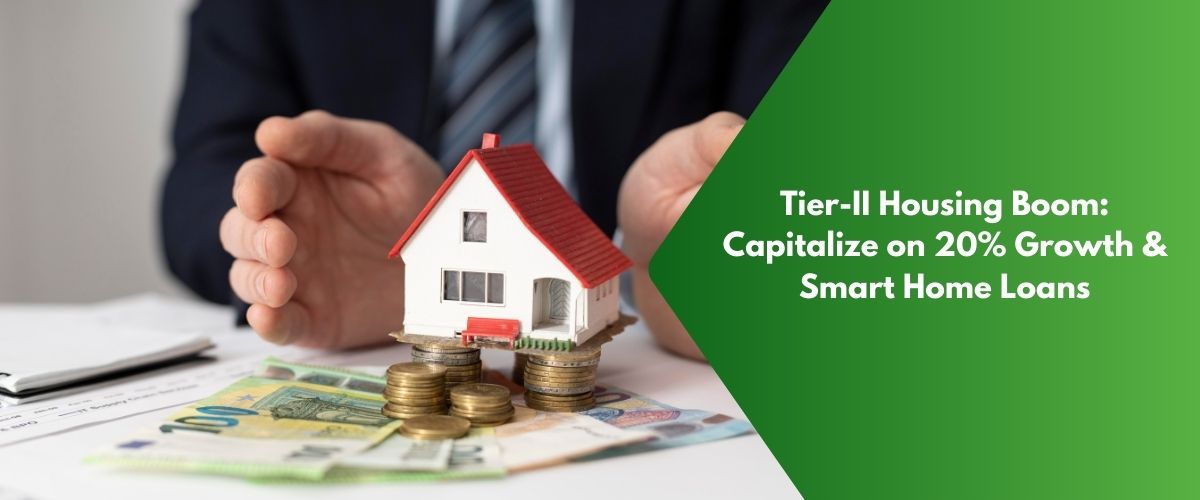The real estate landscape in India’s Tier-II cities is experiencing a significant surge, with a reported 20% growth in housing sales. This Tier-II housing boom presents a golden opportunity for investors and homebuyers alike. Coupled with the availability of smart home loans, this growth trajectory creates a compelling scenario for those looking to capitalize on the market’s momentum.
Understanding the Tier-II Housing Boom: Deeper Insights
The growth in Tier-II cities is fueled by several factors, which are creating a sustainable and attractive housing market.
- Infrastructure Development: Improved connectivity via highways, airports, and metro projects is making these cities more accessible and attractive. This has led to the development of commercial and residential areas, increasing the demand for housing.
- Affordable Housing: Compared to metropolitan areas, Tier-II cities offer more affordable housing options, with lower land costs and construction expenses. This makes homeownership more attainable for a larger segment of the population.
- Growing Middle Class: The expanding middle class in these cities is driving demand for quality housing with modern amenities. Increased disposable income and aspirations for better living standards are key factors.
- Increased Job Opportunities: Decentralization of industries, the growth of IT hubs, and the development of manufacturing sectors are attracting professionals to these regions. This influx of people seeking employment creates a demand for residential properties.
- Government Initiatives: Government initiatives like “Smart Cities Mission” and “Housing for All” are providing further impetus to the housing sector in Tier-II cities.
Capitalizing on 20% Growth: Strategic Approaches
To effectively capitalize on the 20% growth in the Tier-II housing boom, consider these strategies:
- Strategic Location Selection: Identify areas with high growth potential and upcoming infrastructure projects. Focus on locations with good connectivity, proximity to educational institutions, healthcare facilities, and commercial centers.
- Investment in Emerging Projects: Invest in under-construction projects that offer competitive pricing and future appreciation. Early-stage investments can yield higher returns as the projects near completion.
- Rental Property Investments: Leverage the growing demand for rental housing by investing in properties for rental income. Focus on areas with a high concentration of working professionals and students.
- Diversification: Spread your investments across different Tier-II cities to minimize risk. Diversification across property types (residential, commercial) can also enhance returns.
Smart Home Loans: A Catalyst for Growth and Accessibility
Smart home loans are playing a crucial role in driving the Tier-II housing boom. These loans offer:
- Competitive Interest Rates: Attract more buyers with favorable interest rates, making homeownership more affordable.
- Flexible Repayment Options: Provide flexible repayment options to suit diverse financial needs, including step-up and step-down plans.
- Digital Loan Processing: Streamline the loan application process with digital platforms, reducing paperwork and processing time.
- Value-Added Services: Offer additional services like property valuation, legal assistance, and home insurance, providing a comprehensive solution.
Benefits for Homebuyers: Enhancing Quality of Life
- Affordable Housing: Access to quality housing at affordable prices, making homeownership a reality.
- Improved Living Standards: Enjoy modern amenities, better infrastructure, and improved living standards.
- Investment Opportunities: Build wealth through property appreciation, creating a valuable asset for the future.
- Financial Flexibility: Benefit from flexible loan options and competitive interest rates, making homeownership more manageable.
Benefits for Investors: Maximizing Returns and Growth
- High Returns: Capitalize on the 20% growth and generate high returns on investment, exceeding traditional investment avenues.
- Rental Income: Earn consistent rental income from growing demand, providing a stable and reliable revenue stream.
- Portfolio Diversification: Diversify your investment portfolio with real estate assets, reducing overall risk and enhancing returns.
- Long-Term Appreciation: Benefit from long-term property appreciation in growing markets, building substantial wealth over time.
Key Considerations: Due Diligence and Planning
- Market Research: Conduct thorough market research to identify high-potential areas, analyzing growth trends, infrastructure development, and economic indicators.
- Due Diligence: Perform due diligence on properties and developers before investing, verifying legal documents, approvals, and project credentials.
- Financial Planning: Create a comprehensive financial plan and assess your affordability, considering loan terms, interest rates, and repayment options.
- Legal Compliance: Ensure all transactions comply with local regulations and legal requirements, seeking professional legal advice when necessary.
Conclusion:
The Tier II housing boom, coupled with smart home loans, presents a remarkable opportunity for both homebuyers and investors. By understanding the market dynamics and implementing strategic investment plans, you can effectively capitalize on the 20% growth and achieve your real estate goals.
Need expert construction services with high-impact designs and budget-friendly solutions? Visit NGL Construction for top-quality building solutions.
